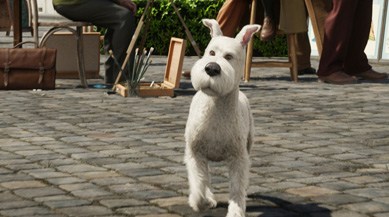Movie Review: The Adventures of Tintin
By Edwin Davies
October 31, 2011
BoxOfficeProphets.com

In short; yes, he could. The reason that The Adventures of Tintin works is that Spielberg has a love and almost innate understanding of animation and how it works. After all, this is the man who designed the lights of the spaceship in Close Encounters of the Third Kind to resemble Roadrunner and decided to halt 1941, his ribald comedy about the aftermath of Pearl Harbor (boy, the '70s were weird), to focus on the impact that a scene from Dumbo has on one of the characters. What Spielberg understands is that animation is a liberating form that allows film-makers to do things that they could never do in live action, and to that end he sprinkles the film with images and sequences that would have been completely impossible in any other medium.
Easily the most stunning and ambitious of these is a chase through the streets of a Moroccan port where Tintin (Jamie Bell), Captain Haddock (Andy Serkis) and Snowy (himself) pursue the villainous Ivanovich Sakkharine (Daniel Craig), who has managed to get his hands on three pieces of paper that form part of a secret. Our heroes are on a motorcycle, the villain in a jeep, and they weave through the streets, dodging pedestrians, flash floods and dancing seconds away from death at every turn, all the while passing the papers between each other in a breathless game of hot potato. The sequence is about five minutes long and is conducted in one single, unbroken shot which, given the ludicrous ambition, complexity and pacing of the action, would have been simply impossible if the film had been live action. It also takes place in a photo-realistic environment, which gives the sequence a physicality that should be at odds with the exaggerated characters, but actually heightens the tension and excitement of the whole scene.
That sequence isn't even the most inventive in the film's arsenal. That honor belongs to a truly stunning section of the film in which Haddock recalls the adventures of his long dead ancestor aboard The Unicorn, a galleon mysteriously lost at sea, which plays out as the most awe-inspiring naval battle I have ever seen. Two ships trade cannonballs, catch fire, then become intertwined as one see-saws through the rigging of the other, creating a gravity-defying spectacle that is truly worthy of the term. It's one of the most ingenious pieces of action directing of the last couple of years and suggests that there must have been a kid-in-a-candy-store glee involved in realising what animation would allow Spielberg to do.
Discussing Tintin's action sequences makes it sound like it's little more than a series of setpieces strung together around a wafer-thin plot. Then again, that's exactly what it is because the plot of Tintin is nonsense. There's not a huge amount of internal logic to it, the characters take huge deductive leaps that only make sense because, hey, it's Tintin and that's what happens in Tintin stories, and much of the forward momentum of the plot is dependent on too-perfect coincidences. Then again, the same thing can be said about Raiders of the Lost Ark, and that is very much the mold that Tintin fits into; nonsense, but exceptionally well-made nonsense. It sets out to deliver thrills, spills and chills with as little extraneous stuff as possible, and at that it succeeds beautifully.
It helps that writers Joe Cornish and Edgar Wright (with Steven Moffat, who wrote the original draft) clearly had a ball writing the Spielberg film that they had always wanted to see but which hadn't been made yet. There's a sense of adventure and fun to the script - which also packs in some terrific jokes and great interplay between Tintin and the perpetually pickled, always alliterative Haddock - that suggests they reveled in the opportunity to write a story about an iconic character for an iconic director and tried to put as much of that excitement on screen as possible.
Whilst the Indiana Jones comparison is an easy - and apt - one to make, it's also slightly misleading since Tintin lacks the darkness of those films. Most notably, it lacks a decent villain, since Craig's Sakkharine is so toothless and benign that whenever he isn't onscreen it's difficult to remember who exactly Tintin and Haddock are meant to be chasing after. It's also pitched at a much younger audience, as evidenced by the frequent detours into the bumbling slapstick of Inspectors Thompson and Thomson (Simon Pegg and Nick Frost) as they hunt down a pickpocket which are only tangentially related to the main plot and can be a bit trying for anyone over eight. On the other hand, you can't take a film to task for trying to appeal to as broad an audience as possible, especially when it does so in a way which is good-natured, fun and doesn't resort to crass, lowest common-denominator pandering. Tintin, like the best Spielberg films, taps into a universal sense of wonder and adventure that crosses all ages and borders, making it as pure a piece of blockbuster entertainment as you are likely to see this year.